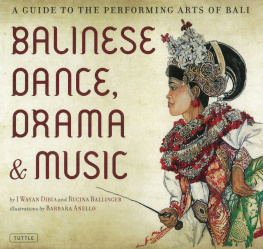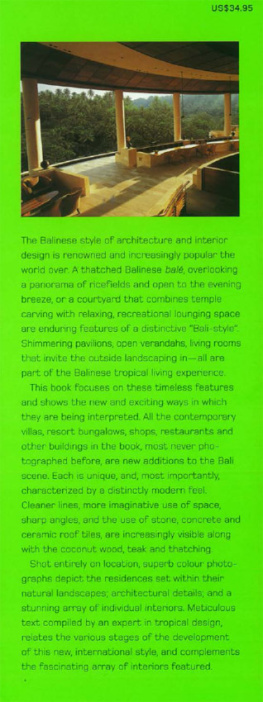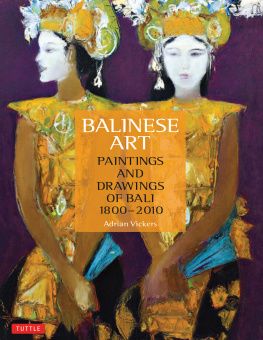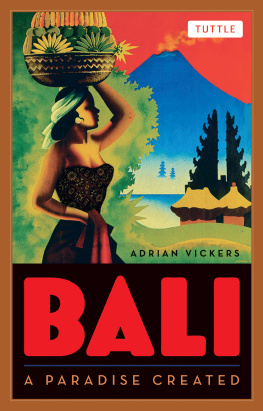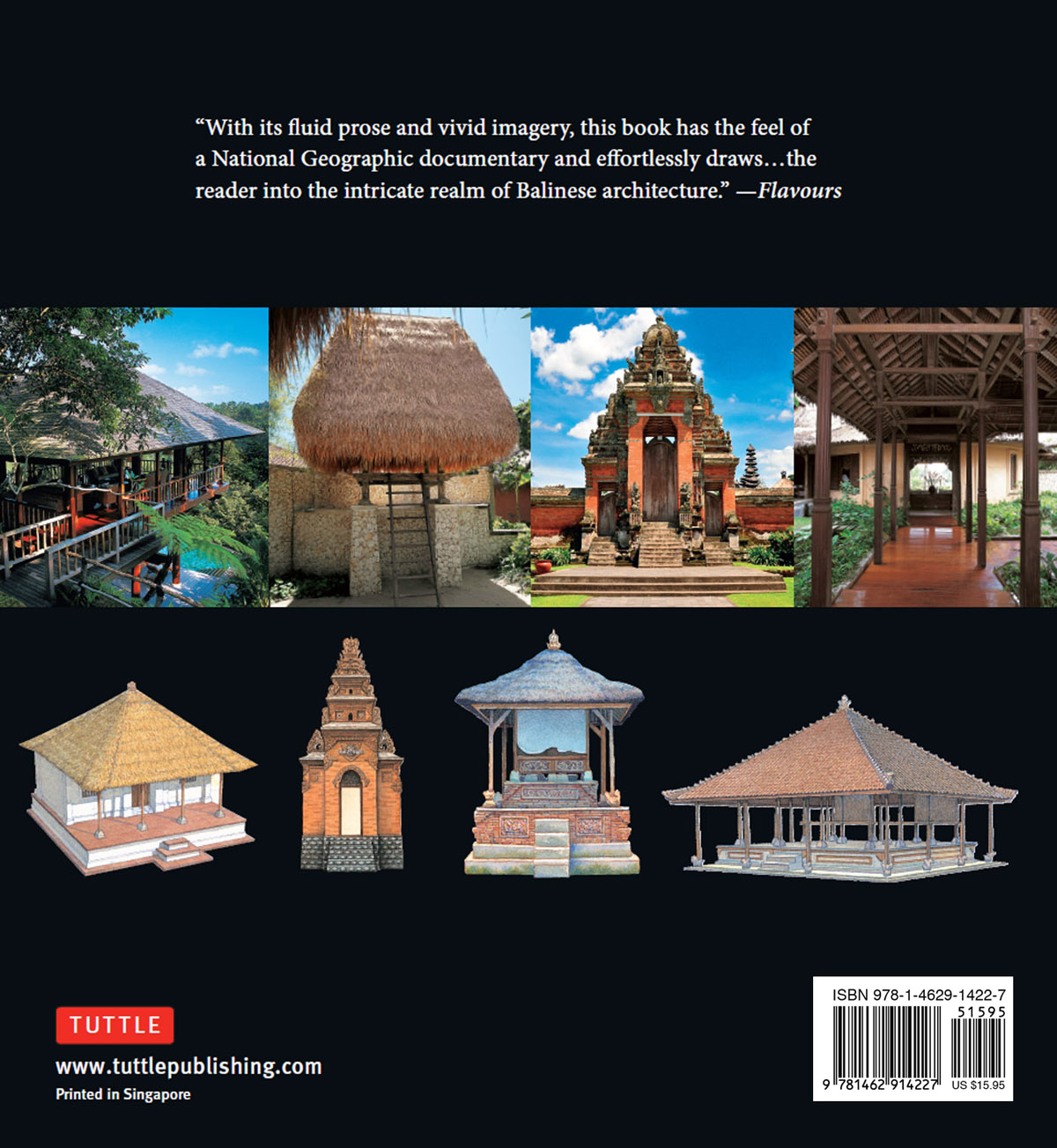Bibliography
Architecture, Vol. 6 Indonesian Heritage, Singapore: Archipelago Press, 1998.
Bali , Archipelago Guides, New York: Alfred A. Knopf, 1995.
Bali , Indonesia (ed. Eric Oey), Periplus Adventure Guides, Singapore: Periplus Editions, 2001.
Belo, Jane, Bali: Temple Festival, Seattle: University of Washington Press, 1966.
Bernet Kempers, A. J., Monumental Bali: Introduction to Balinese Archaeology & Guide to the Monuments, Singapore: Periplus Editions, 1991.
Budihardjo, Eko, Architectural Conservation in Bali , Yogyakarta: Gadjah Mada University Press, 1986.
Byfield, Graham and Darling, Diana, Bali Sketchbook, Singapore: Archipelago Press, 1998.
Carpenter, Bruce W., W. O. J. Nieuwenkamp: First European Artist in Bali , Singapore: Periplus Editions and the Netherlands: Uitgererij Unipers Abcoude, 1997.
Covarrubias, Miguel, Island of Bali, New York: Alfred A. Knopf, 1937; reprinted Singapore: Periplus Editions and Antiques of the Orient, 1995.
Dawson, B. and Gillow, J., Traditional Architecture of Indonesia, London: Thames and Hudson, 1994.
de Zoete, Beryl and Spies, Walter, Dance & Drama in Bali, London: Faber and Faber, 1938; reprinted Singapore: Periplus Editions, 2002.
Eiseman, Fred B., Bali: Sekala & Niskala (2 vols): Essays on Religion and Art (Vol. 1); Essays on Society , Tradition and Craft (Vol. 2), Singapore: Periplus Editions, 1990.
____, Woodcarvings of Bali , Singapore: Periplus Editions, 1988.
Francione, Gianni and Tettoni, Luca Invernizzi, Bali Houses: New Wave Asian Architecture and Design, Singapore: Periplus Editions, 2002.
____, Bali Modem: The Art of Tropical Living, Singapore: Periplus Editions, 2000.
Fox, James (ed.), Inside Austronesian Houses: Perspectives on Domestic Designs for Living , Canberra: Australian National University, 1993.
Geertz, Clifford, Internal Conversion in Contemporary Bali, in The Interpretation of Cultures , New York: Basic Books, 1973.
Goris, R., The Temple System, in W. F. Wertheim (ed.), Bali: Studies in Life , Thought and Ritual , The Hague: Van Hoeve, 1960.
Hitchcock, Michael and Norris, Lucy, Bali , The Imaginary Museum: The Photographs of Walter Spies and Beryl de Zoete , Kuala Lumpur: Oxford University Press, 1995.
Hobart, Angela; Ramseyer, Urs, and Leemann, Albert, The Peoples of Bali , Oxford: Blackwell Publishers, 1996
Hobart, Mark, The Path of the Soul: The Legitimacy of Nature in Balinese Conceptions of Space, in G. Milner (ed.), Natural Symbols in South-East Asia, London: School of Oriental and African Studies, 1978.
Hooykaas, C., Cosmogony and Creation in Balinese Tradition, The Hague, 1974.
Howe, L., An Introduction to the Cultural Study of Traditional Balinese Architecture, Archipel, 25, 1983, pp. 137-58.
Jensen, Gordon D. and Luh Ketut Suryani, The Balinese People: A Reinvestigation of Character , Singapore: Oxford University Press, 1992.
Kwa Chong Guan, Sraddha Sri Rajapatani: An Exploration of Majapahit Mortuary Ritual, in The Legacy of Majapahit, catalogue of an Exhibition at the National Museum Singapore, Singapore National Heritage Board, 1995.
Made Wijaya, Architecture of Bali: A Source Book of Traditional and Modern Forms, Singapore: Archipelago Press and Wijaya Words, 2002.
Ramseyer, Urs, The Art and Culture of Bali, Singapore: Oxford University Press, 1986.
Santiko, Hariani, Early Research on Savaitic Hinduism During the Majapahit Era, in The Legacy of Majapahit , catalogue of an exhibition at the National Museum Singapore, Singapore National Heritage Board, 1995.
Simmonds, Nigel and Tettoni, Luca Invernizzi, Bali: Morning of the World, Singapore: Periplus Editions, 1999.
Soebadio, H., The Documentary Study of Traditional Balinese Architecture: Some Preliminary Notes, Indonesian Quarterly, 3, 1975, pp. 86-95.
Spruit, R., Artists on Bali , Amsterdam: Pepin Press, 1995.
Stuart-Fox, David J., Once a Century: Pura Besakih and the Eka Dasa Rudra Festival, Jakarta: Sinar Harapan, 1982.
Swellengrebel, J. L., Een vorstenwijding op Bali , Leiden, 1947.
Tadgell, Christopher, The History of Architecture in India, London: Phaidon Press, 1990.
Tan, Rita, The Domestic Architecture of South Bali, Bijdragen tot de Taal-, Land- en Volkenkunde, 123(4), 1967, pp. 442-75.
Vickers, Adrian, Bali: A Paradise Created , Penguin Books Australia, 1989; reprinted Singapore: Periplus Editions, 1990.
Warren, Carol, Adat and Dinas: Balinese Communities in the Indonesian State , Kuala Lumpur: Oxford University Press, 1995.
Warren, William and Tettoni, Luca Invernizzi, Balinese Gardens, 2nd edn, Singapore: Periplus Editions, 1997.
Waterson, Roxana, The Living House: An Anthropology of Architecture in South-East Asia, Kuala Lumpur: Oxford University Press, 1990.
Balinese Architecture and Belief Systems
The archetypal Balinese residencefrom the humblest abode to the grandest palacereflects an ancient architectural tradition which has its origins, at least in part, in India. Metaphysics, Hindu religious beliefs, cosmology, ritual, function, and climate all combine to determine the location, shape and function of buildings.
Divided in Three
The tripartite division of the universe dovetails with the concept of tri angga , which assumes that everything in the natural world can be divided into three parts. Utama , which denotes things that are high or above, is identified with mountains and, by extension, the gods who dwell there, heaven and the ancestors, and all that is pure or sacred. Nista denotes things that are low or below, including the sea and any malevolent spirits, hell and the dead, the impure and the profane. Man occupies the middle ground of madya , the mundane world of everyday existence, a hinterland that stretches from the seashore to the foothills of the central mountain range. The human body can be similarly divided into three parts-head, torso, and feet. This tripartite scheme of things extends to the components of the simplest built structurethe base, the walls or posts, and the roof.

Most often, the Balinese residence comprises a collection of low-profile pavilions set in a walled compound ( pekarangan ), surrounded by fruit trees and ornamental shrubs. Each building is placed on a low plinth and surmounted by a hipped roof clad with clay pantiles or grass thatch. Some structures are open-sided, while others are enclosed by masonry walls. Each building has a specific function.
Microcosm and Macrocosm
Balinese architecture is grounded in a metaphysics that presents the universe as an integrated whole, where each part participates in the existence of every other part, and where the microcosm is perceived as a reflection of the macrocosm.
Correct orientation in space, combined with ideas of ritual purity and pollution, are key concepts, providing a cosmological framework for maintaining a harmony between man and the rest of the universe. This view of the world derives from the Hindu idea of a divine cosmic order (dharma).
Balinese Hinduism
Indian religious beliefs in Southeast Asia date from the time of Christ when Indian merchants first developed trade links with the region. Balinese Hinduism, however, probably owes more to Javanese influences between the 14th and 16th centuries than it does directly to the Indian subcontinent. This was the era of the mighty East Javanese Majapahit empire (1292-c. 1525) whose political and cultural influence at its height extended over much of the Indonesian archipelago, including Bali. The Majapahit dynasty was the last in a long line of Hindu-Buddhist kingdoms in Java which in earlier centuries had been responsible for building the great temple complexes at Borobudur and Prambanan.


